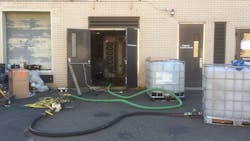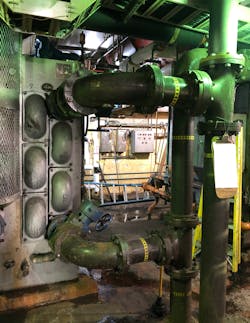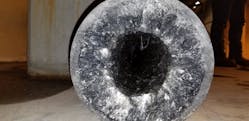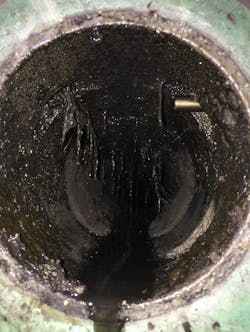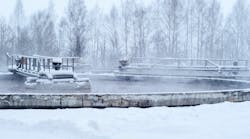The Rockland County Sewer District No. 1 (RCSD #1) did not expect the problem behind its heat exchangers to be struvite.
Rockland County is located 30 miles north of New York City, along the Hudson River. Comprising five towns, it's a vibrant and diverse community known for its charming villages and beautiful river views. With a population of 339,000, Rockland County is the third most densely populated county in New York State.
RCSD #1 was established in 1963 to provide essential sewer services to the residents of Rockland County, primarily the towns of Ramapo and Clarkstown. RCSD #1 operates and maintains the system's major interceptors and pumping stations, and the team is dedicated to fulfilling its mission of providing essential sewer services to safeguard and improve the county’s water resources in an ethical, timely, and cost-effective manner. As it serves the community, RCSD #1 must adhere to local, state, and federal environmental regulations while maximizing energy and operational efficiency.
Troubleshooting heat exchangers’ efficiency problems
The RCSD #1 treatment plant treats an average of 18 million gallons per day (MGD), with a design capacity of 29 MGD.
The plant utilizes anaerobic digesters to break down the organic matter of its raw sludge to produce the feed sludge which will get de-watered during the solids handling process. The result is a solid material that is safe for disposal. The digestion process benefits from using heat exchangers, which raise the sludge temperature to the ideal range for maximum efficiency.
Any drop in temperature compromises the biological reaction and has a negative impact on the plant’s operations. When biological processes slow down, it reduces the decomposition of solids.
For RSCD #1, this led to higher costs for the final removal and disposal of the solids. It also resulted in insufficient biogas production for RCSD #1’s cogeneration engine, increasing fuel costs and carbon emissions for the plant.
For the next five years, their ability to maintain proper temperature continued to decrease as the team at RCSD #1 struggled to identify the source. They checked the furnace, pumps, pipes, and insulation for the digesters but could not find the issue.
“It was a slow process to figure out what was causing the problem,” said Richard Hagen, Chief Operator for RCSD #1, noting that, initially, his team did not consider a clog as heat exchangers rarely experience such an issue.
Even so, with few options left to explore, Hagen wondered if mineral buildup could be causing the performance problems. He reached out to his contacts at Grignard Company, who suggested the problem might be related to struvite.
The RCSD #1 team had worked with the company previously, using Grignard’s product Struvicide Soak to remove a struvite clog that had rendered 460 feet of pipe unusable for more than ten years.
Struvite buildup in an unexpected place
Struvite is a natural by-product of wastewater treatment and a common problem for plant operators. Struvite develops and accumulates in the presence of magnesium, ammonia and phosphate, forming a cement-like scale. It can be found in anaerobic digesters, pipes, valves, pumps, mixers, centrifuges, and other equipment.
In heat exchangers, struvite can make it challenging to maintain the proper temperature. Even a minimal buildup can significantly reduce a plant’s efficiency, damage equipment, and increase energy consumption.
To Hagen’s surprise, the Grignard team discovered a thin layer of struvite coating the internal surfaces of the heat exchanger pipes. Even though the sludge was flowing through the heat exchangers at a relatively normal rate, the struvite was there, not creating a clog but acting as an insulative barrier and impeding the heat transfer vital to optimizing the anaerobic digestion process. As a result, the overall performance of the plant’s system was being negatively impacted.
“We’ve learned that it’s possible for a plant to have a struvite problem in the heat exchanger and not even realize it, especially when flow rates are normal,” said Hagen.
Returning the heat exchangers to optimal efficiency
Removing struvite buildup is a challenging task.
Over the years, various methods to remove it have been introduced, ranging from electronic descaling and mechanical grinders to hydro blasting and other chemical methods.
Grignard’s product Struvicide Soak is a proprietary, biodegradable solution that dissolves blockages of struvite, vivianite, calcium carbonate and other mineral buildups in process equipment, heat exchangers, and pipes. It works by removing the limiting ion from struvite, breaking the bond of the chemical structure and dissolving the mineral in solution. The struvite solution is non-corrosive, non-toxic, non-flammable, and does not pose a threat to operators.
In November 2021, the Grignard team performed a thorough cleaning of all three heat exchangers within a span of ten days. The process involved several steps, including shutting down one heat exchanger at a time, draining the sludge, and releasing air from the pipes.
The team then injected the solution into the pipes. Once the soaking and agitation were complete, the team flushed the pipes, reassembled the equipment, and disposed of the spent solution containing all the dissolved struvite. The process removed the struvite buildup from the pipes in all of RCSD #1’s three heat exchangers.
“Struvite is a stubborn mineral that is hard to remove entirely. It was amazing to see the struvite come off in thin layers,” said Hagen, who notes that, over the years, he has tried many methods to deal with struvite, all with varying results.
Given the operational disruptions caused by struvite, many plant managers are keen to employ maintenance methods to keep the struvite at bay. Heat exchangers, however, present a challenge. Unlike other applications, where chemicals can prevent mineral buildup over time, they cannot be run through the heat exchanger while in service because the chemicals should not enter the biological vessel.
Since the cleaning, the heat exchangers have been running with minimal loss of efficiency, particularly during the winter months when the demand to heat the system is greater. The cleaning project also helped reduce carbon emissions and energy costs at the plant.
Given the high concentrations of magnesium, ammonia, and phosphate in Rockland County’s wastewater, RCSD #1 plans to do another preventative cleaning before winter 2024.
“We spent five years trying to figure out what was affecting the performance of our heat exchangers,” said Hagen. “Now that we know the problem is struvite and Grignard’s process is so straightforward and effective, it makes sense from a financial and operational perspective to conduct a routine cleaning to prevent any performance issues from popping up.”
